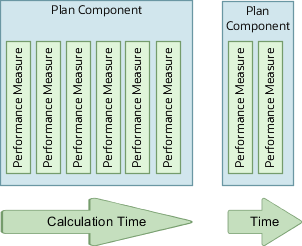Best Practices for Configuring Compensation Plans
The way a plan is configured can affect downstream processes like the performance of calculations and plan deployment. It can also affect the maintenance effort of analysts who have to run day-to-day operations on participants assigned to these plans.
Reporting is also an important aspect to consider on how a plan should be configured. You have a lot of flexibility to configure plans in different ways. Though the final results of a calculation could be the same irrespective of how a plan is configured, there are good plan configurations and bad plan configurations.
Plan Calculation Per Event or Per Interval
If you don't need to report the earnings per transaction, for better calculation performance always consider defining a plan component with Calculate Incentive Per Interval. If you need to report the earnings per transaction, define the plan component Per Event.
Number of Performance Measures
Assigning a large number of performance measures to a component can negatively affect calculation performance. Calculation must create the measure results for all those measures. So restrict the number of measures per plan component to only those that are necessary.
This figure shows the difference in calculation time when your plan component contains less performance measures.

Credit Categories Assigned to Performance Measures
Only assign credit categories to a performance measure if its formula refers to a transaction attribute. If the formula (input or output expressions) doesn't refer to any transaction attribute, there's no need to assign a credit category. This enhances calculation performance.
The Same Performance Measure Used in Multiple Components
When you save your changes to a performance measure, it's validated. Any plans and plan components that use that performance measure are also validated. You experience a longer delay when you save that measure if it's assigned to too many components and plans.
Plan Configuration for the New Compensation Year
Create new plans for the new compensation year even if you have no changes to the plans. This avoids the risk of inadvertently changing prior year plans in the case of midyear changes in the current year. It also improves overall performance such as plan deployment and improves the ease of use in plan documents. Use the Manage Compensation Plan Import Process to copy plans from one year to the next and configure them with minimal effort.
Generic Display Name Field
Enter a value in the Display Name field that's generic enough to apply to future years. For example, your plan component is FY20 Green Server Commissions. Make the display name Green Server Commissions. Then when you copy the plan to FY21, your name will be FY21 Green Server Commissions. But the display name remains Green Server Commissions and your reports aren't affected.
Storing Personally Identifiable Information
It's a best practice to not store PII data in transaction tables. This is especially important for General Data Protection Regulation rules.